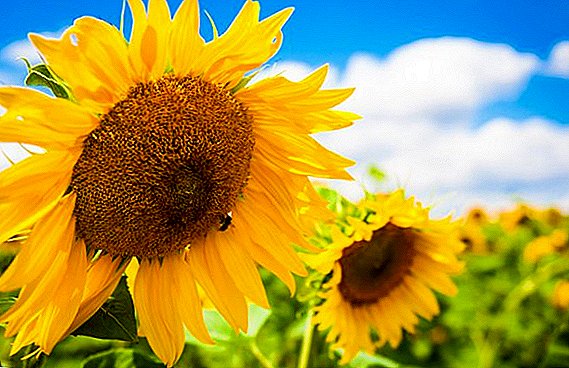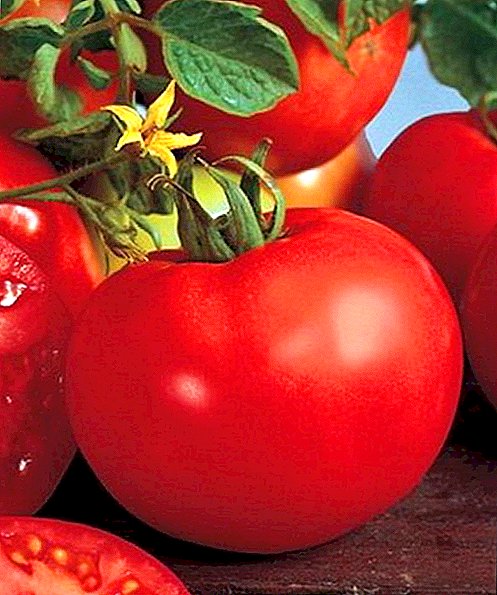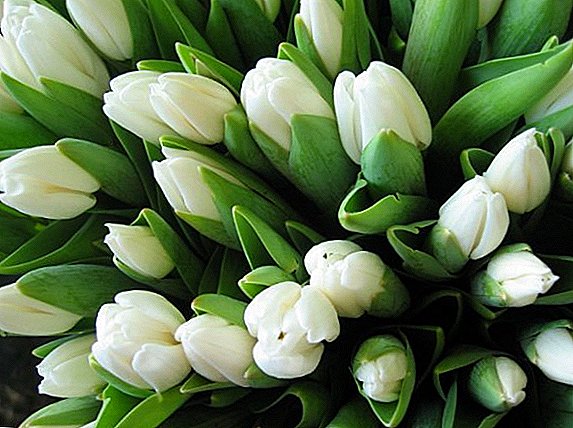 These perennial bulbous herbaceous plants of the lily family with amazing beauty with flowers of different shapes and sizes can hardly leave anyone indifferent. Tulips are strongly associated with spring, freshness and International Women's Day, and white tulips epitomize purity and novelty. Let's take a closer look at what white tulips are and what they can bring to your garden.
These perennial bulbous herbaceous plants of the lily family with amazing beauty with flowers of different shapes and sizes can hardly leave anyone indifferent. Tulips are strongly associated with spring, freshness and International Women's Day, and white tulips epitomize purity and novelty. Let's take a closer look at what white tulips are and what they can bring to your garden.
What are the white tulips
All varieties of tulips are divided into four groups: early flowering, medium flowering, late flowering and specific. Among the existing fifteen classes, the most numerous flowers of the Triumph class are especially distinguished, which are popular fringed, lilian-colored, green-colored and others.  White tulips have many shades: from snow white and milky to all sorts with multicolored divorces at the base or border along the edges of the petals - yellow, pink, green, etc.
White tulips have many shades: from snow white and milky to all sorts with multicolored divorces at the base or border along the edges of the petals - yellow, pink, green, etc.
Did you know? Tulips were cultivated in the Middle East, for example, already in the XI century, the Seljuk people considered these flowers to be one of their symbols, and in Europe they were planted only in the XVI century.
Description and names of the most popular white tulips
A large variety of white tulips are known today: early and late, large and small, classical and multi-colored ... Let us consider in more detail only some of the most common ones.
"Antarctica"
This variety is universal. It is perfect for landscape design, and for forcing and cutting. The snow-white "Antarctica" belongs to the group of medium-flowering tulips of the class Triumph and is distinguished by the classical goblet shape (the height of the glass is up to 7 cm, the diameter is up to 5 cm). Plant height - from 40 cm to 60 cm, the flowering period falls in April-May. In open ground, flower petals may have a yellow back. These flowers multiply well and are in demand when making bouquets, especially for young girls. 
"Smirnoff"
The flower of this variety is large, white, with a tall glass (7-9 cm), having a thin needle-like fringe at the edges of the petals. Plant height - from 40 to 60 cm. The flowering period is May. Looks great on the flowerbed, creating an image of a frost-covered cloud. Also used for forcing and cutting. 
"White Dynasty"
Beautiful elegant flower of class Triumph, especially loved by florists for its beauty and endurance. "White Dynasty" has a taut white glass (height - up to 8 cm, width - up to 6 cm) and a dense strong stalk. Plant height - up to 65 cm, in the open field - usually about 40 cm. Flowering period - April-May (from ten days to two weeks). 
"White Heart"
This variety belongs to the early terry tulips and has a lush white inflorescence. Plant height is up to 45 cm, blooms in April. Perfectly adorns the flower beds in the garden, and is also suitable for cutting. 
"Agrass White"
It is a classic large flower of the class Triumph: a slightly elongated shape with slightly pointed petals, which gives some similarity with lilianseltnymi tulips. Color - white and milky, with a longitudinal light green stripe on the back of the petal. The height of the glass is 6-10 cm, the diameter is up to 5 cm. The height of the plant is 50-60 cm. It reproduces perfectly and gives an excellent forcing. Flowering occurs at the end of April-early May. 
"Alaska Star"
"Alaska Star" - a grade of class Triumph perfectly suitable for cutting. The flower is a classic, goblet-shaped, pure white color, the stem length of which is about 50 cm. It blooms in late April-early May. 
"Athleet"
Another representative of the class Triumph, which perfectly decorate with itself any flower bed and is perfect for cutting. The flower is medium in size, white in color, the length of the stem is 45 cm. Like all members of the medium-flowering group, it blooms in late April-early May.
Where do white tulips best grow
White tulips are no different from their fellow counterparts whimsical or need for special care. Best of all, they grow in a well-lit and protected from the wind place.
Soil requirements
The soil for growing tulips should be moderately moist, loose and fertile, with a neutral or alkaline reaction. Acid soils are unsuitable for planting tulips and require liming. The minimum thickness of the fertile layer should be 35 cm. Sandy or heavy clay soils, as well as soils with a high level of groundwater, are not suitable for flower beds.  A couple of months before planting the ground must be prepared:
A couple of months before planting the ground must be prepared:
- dig up;
- apply fertilizer: rotted manure (4-7 kg per square meter) or compost (3-5 kg per square meter);
- loosen and level.
A week before planting, a place for the flower bed should be re-digged with fertilizer (nitrogen, phosphate and potash - 30 g, 60 g and 40 g per square meter, respectively).
Important! It is not recommended to plant tulips in their old place or in the place where other bulbous plants were grown before 4-5 years earlier, since they have common diseases and pests. To arrange a flower bed in the old place before this period, it is necessary to replace the soil.
The choice of lighting
The best place for a flower bed with tulips will be a flat sunny plot, well protected from strong winds. Bright natural light will ensure good development of the bulbs, the stems of tulips will be smooth, the flowers will be large, and the flowering period will be long. In shady places only planting of late-flowering species is allowed, as this may have a beneficial effect on the duration of their flowering.
Learn how to care for tulips when they have faded, and how to propagate them.
Optimum humidity
Best of all tulips feel at a relative humidity of air - no more than 80%. High humidity threatens these flowers with many diseases (topping, gray rot, foliage defects). With regard to soil moisture, watering tulips should be carried out after the soil dries, because an excess of moisture in the ground will not benefit them as much as a strong drying. 
Features and basic rules of landing
Planting tulips can be autumn or spring. To get an early and long flowering, it is recommended to plant the bulbs in autumn - around the end of September-the second decade of October. However, the best criterion for determining the landing time is the average daily temperature of the soil, measured at a depth of about 15 cm. A stable figure of +10 ° C indicates that the right moment has arrived.
Read also when planting tulips - in the fall or spring.The ideal temperature is +7 ° C, but it’s not worth waiting for this level, since the bulb should have time to root before the first frost, which usually takes up to three to four weeks on average. For planting, you need to select a good planting material, that is, the largest and most healthy bulbs, which should be treated with a weak solution of potassium permanganate or antifungal medication. Soil need to dig in advance and fertilize.
Important! Good planting material can be obtained by breaking flower heads at the very beginning of flowering (decapitating plants).First, early flowering varieties are planted, after a week or two - late flowering. The correct planting depth is three onion heights, which is an average of 15 cm. On heavy soils, the depth should be a couple of centimeters less. Usually the bulbs are planted individually with an interval of 8-10 cm from each other, and the distance between the rows is about 20-25 cm.
 The size of the bulb affects the area of nutrition it needs: the large ones are planted less frequently, the smaller ones are closer to each other. The smallest bulbs can be sown in the furrows. It is recommended to lay a layer of sand about two centimeters thick at the bottom of the furrow, especially on heavy soils.
The size of the bulb affects the area of nutrition it needs: the large ones are planted less frequently, the smaller ones are closer to each other. The smallest bulbs can be sown in the furrows. It is recommended to lay a layer of sand about two centimeters thick at the bottom of the furrow, especially on heavy soils.Important! With the onset of frost, a plot with tulips to preserve and increase the decorativeness and yield is desirable to mulch with peat, compost, dry leaves, or straw, which must be removed in the spring.
Video: proper tulip planting
Flower care
Tulip care begins in the earliest spring and includes:
- inspection of plants;
- removal of diseased and unsprouted bulbs along with a clod of earth;
- weeding and weed control;
- top dressing with fertilizers;
- loosening the soil;
- regular watering;
- pest control.
To emphasize the beauty of tulips in a flowerbed, such flowers are planted next to each other - muscari, hyacinths, daffodils, daisies, viols, forget-me-nots, anemones and roses.
Watering rules
Maintaining optimum moisture for the growth and blooming of tulips is very important. Tulips should be watered as the soil dries, as excessive moisture can cause bulbs to rot. However, this does not mean that these plants like dryness. On average, about 20 liters of cold water should be used to irrigate one square meter of flowerbed. You can not water the flowers directly from the hose, as a strong jet can damage the plants.  Experienced gardeners recommend making shallow grooves near the flower beds, through which to irrigate. This will help to moisten the soil well without compromising the colors. After watering the soil should be slightly loosened and weed weed. At the end of the flowering period, watering is stopped.
Experienced gardeners recommend making shallow grooves near the flower beds, through which to irrigate. This will help to moisten the soil well without compromising the colors. After watering the soil should be slightly loosened and weed weed. At the end of the flowering period, watering is stopped.
Pruning
When the flowering period ends, it is recommended to remove all fallen petals to prevent rotting of the root system, and cut off faded flower stalks and leaves. Terms of trimming and digging the bulbs can vary, but on average they are 2-4 weeks after flowering. Only completely wilted plants should be pruned, because early pruning can damage bulbs, which, after the flower wilts, are actively stocked with nutrients.
Tulip tree - unusual and very beautiful.In order not to damage the bulbs when digging, it is necessary to mark the places where they are located during pruning. Ripened onions are to be dug out - with brown spots on the scales and formed roots. After digging, they should be dried in the sun and stored before planting in a dark, dry place at a temperature of about +17 ° C.
Did you know? In Russia, tulips appeared thanks to Peter I, he even founded a company that dealt exclusively with the import of bulbs of these flowers from Holland.
Video: how to properly trim after flowering
Top dressing
Tulips are recommended to feed three times: in early spring, during budding and during full bloom. The choice of fertilizers - organic or mineral - depends on the preferences of each gardener. If we are talking about mineral fertilizers, then nitrogen fertilizers should be applied in the first feeding in early spring; in the second - phosphoric and potash; in the third - potash. In this case, it is necessary to take into account the type of soil: heavy soils require an increased dose of nitrogen fertilizers and a reduced dose of phosphate fertilizers, and light soils - vice versa.  The use of organic matter in the cultivation of tulips is also permissible, but it is important to remember that fresh manure can be applied to the flowerbed no later than a year before planting flowers, since an excess of nitrogen will have a bad effect on the condition of the plants. Dead manure and compost will not harm flowers. In early spring, you can make a bed and wood ash. Thus, the bulbs will receive sufficient nutrition for their development. Too much fertilizer beds are not worth it, because overfeeding can adversely affect the condition of the bulbs, which will become more susceptible to pests and diseases.
The use of organic matter in the cultivation of tulips is also permissible, but it is important to remember that fresh manure can be applied to the flowerbed no later than a year before planting flowers, since an excess of nitrogen will have a bad effect on the condition of the plants. Dead manure and compost will not harm flowers. In early spring, you can make a bed and wood ash. Thus, the bulbs will receive sufficient nutrition for their development. Too much fertilizer beds are not worth it, because overfeeding can adversely affect the condition of the bulbs, which will become more susceptible to pests and diseases.
Tulips need fertilizing, which includes ammonium nitrate, urea and potassium.
Pest and disease control
White tulips can suffer from various infectious and non-communicable diseases, as well as pests. Adverse soil-climatic and agrotechnical conditions can contribute to their appearance, including: too high or low soil temperatures during planting or digging, mechanical damage, prolonged transportation, improper storage, etc.
It will be interesting to get acquainted with the varieties of tulips.The most common diseases of tulips are: gray and sclerotsial rot, typholes, fusarium, penicillosis, variegation and August disease, as well as root and bacterial rot of bulbs, late blight and rust. In order to protect the flower bulbs from potential diseases, it is possible to carry out the treatment with special antibacterial and antifungal agents (Bordeaux liquid, "Chom") before planting.
 Bordeaux liquid. Pests that often threaten tulips are the root onion mite, the violet shovel, the onion hover, the Maybike, and the common bear, wireworm and mouse-like rodents. Timely weeding, loosening the soil and spraying the plants with appropriate means ("Fundazol", "Karbofos") help the pests well.
Bordeaux liquid. Pests that often threaten tulips are the root onion mite, the violet shovel, the onion hover, the Maybike, and the common bear, wireworm and mouse-like rodents. Timely weeding, loosening the soil and spraying the plants with appropriate means ("Fundazol", "Karbofos") help the pests well.Did you know? During World War II, food supplies to the Netherlands were blocked and many Dutch people were saved from starvation by using tulip bulbs, which they boiled and eaten.To reduce the risk of unpleasant symptoms of diseases or pests in white tulips, you should follow preventive measures:
- choose a suitable site;
- be sure to carry out preparatory work with the soil before planting;
- timely make organic and mineral fertilizers to the extent necessary;
- observe the crop rotation - planting tulips in the same place no earlier than after 4 years;
- carefully select healthy planting material;
- when planting bulbs to comply with the rules regarding the required depth and density;
- maintain good sanitary conditions of the flower bed;
- time to clean and dry the bulbs in the open air or in a ventilated room;
- disinfect the container for storing bulbs and cutting tools;
- completely remove and destroy diseased plants: from roots to leaves and flowers.

How to make a perfect flower bed: tips on the right combination
Each gardener is in some way an artist and many flower beds formed in different areas often differ in their individuality and originality. However, there are some useful tips that should be considered before planting tulips in order to get a truly beautiful composition as a result.
- When forming the flower bed, it is necessary to take into account the time of flowering of selected varieties of tulips.
- When choosing a site for planting should pay attention to the height of the plants. High varieties are recommended to be planted in the middle of the flower bed or at its far edge, so that they do not block other flowers.
- Smaller flowers should be planted around the edges of the flower beds - so the composition looks more harmonious.
- It is necessary to take into account the sprawl characteristic of each variety in order to determine the optimal density of the bulb planting.
- When planting white tulips next to red for the next year you can get white tulips with red veins.
- In the composition with tulips of light tones (for example, pink ones) a white tulip will be a unifying factor, and in compositions with bright colors (orange, red, purple) will emphasize their expressiveness.
 Taking into account all the above tips and recommendations, you can create a wonderful tulip flower bed, endearing everyone with its beauty, and with proper care for these wonderful plants, you can not only save the bulbs for later planting, but also increase their number.
Taking into account all the above tips and recommendations, you can create a wonderful tulip flower bed, endearing everyone with its beauty, and with proper care for these wonderful plants, you can not only save the bulbs for later planting, but also increase their number.











